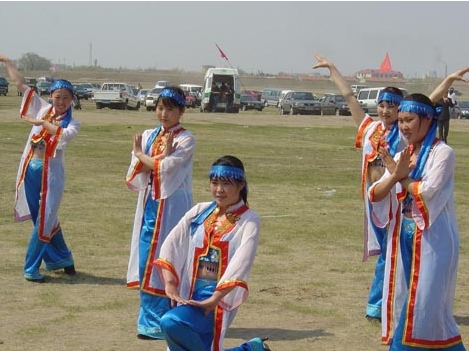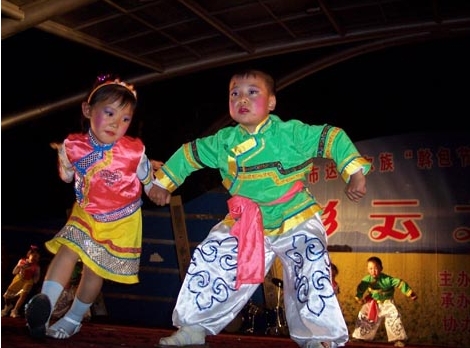
"Lurigele" is a kind of representative folk dance in Daur. It differs in different places, and has several different names such as "Ahanbo", "Langtudabei", "Hakumai" , "Hagenmaigele" and so on.
In the inhabited district of Daur Minority in Inner Mongolia and the Nenjiang River valley of Heilongjiang, "Lurigele" dance is a general term for all folk dances there, most of which are self-entertainment dances performed by women. According to textual researches, the Chinese meaning of "Lurigele" is "Burning" or "flourishing", and the Daghur expression of "Lurigelebei" has the connoted meaning of "spring up". And since the dancers would be shouting "hanbo, hanbo" during the performance, so "Lurigele" is also called "Hanbo Dance".
"Lurigele" dance has a long history. According to historical records, during the night of the early spring in ancient times, the Daur people would gather around the blazing bonfire dancing and shouting on the lawn at the end of the village to express their feelings, adjust mental state and dissipate fatigue in the form of dance in their free time. Thus we can see that "Lurigele" has everything to do with the production, life and convention of the Daur people.

The Daur people are good at dancing and singing, and "Lurigele" gives priority to group dances, which mainly manifest scenes of hunting and production activities. During the dance, there are more movements on the upper body and arms of the dancer, while the basic steps under feet are sidesliping. At first, light and slow dance song was sung, the dancer would begin dancing gently to the song, standers-by can join the group at will, then the dancing atmosphere became intense, rhythm became faster, dancers kept shifting and changing positions, and when it reached to the climax, dancers give out short funny cries such as "Zheheizhe", "Dehuda" etc. and step in forceful tempo together. "Lurigele" stems from the laboring and production life of the Daur people, so there are contents and dancing images of collecting, carrying water, fishing, flying, birds fights etc. in the dance. Now in the cradle of the Lurigele dance, this folk dance is given much absent treatment and facing a crisis of being lost and needs exigent protective measures.
Daur is a people good at equitation, archery, dancing and singing. The Lurigele dance of Daur people inhabited in Heilongjiang Province is also called "Hakumaile". On the one hand, it has the characteristics of traditional hunting dances and music, for instance, the circular group shape kept from primitive bonfire dancing and singing, and barks and calls in imitation of beasts and fowls; on the other hand, it has gotten quite great development, for instance, varying changes in group shape, increase of new songs, wider contents of songs and dances, richer and more unique aside etc. To speak of, the Hakumaile dance has relatively clear-cut "3-episode" performing program. The first episode gives priority to "singing contest", while dances play a supplementary role; the second is "dance contest", which gives priority to dancing, and singing is supplementary; the third "fighting", which gives priority to fights, in which performers reach out their arms to each other, fighting and twisting around with each other with the loud and heated cries and finally end the dancing and singing performance by battling it out.





